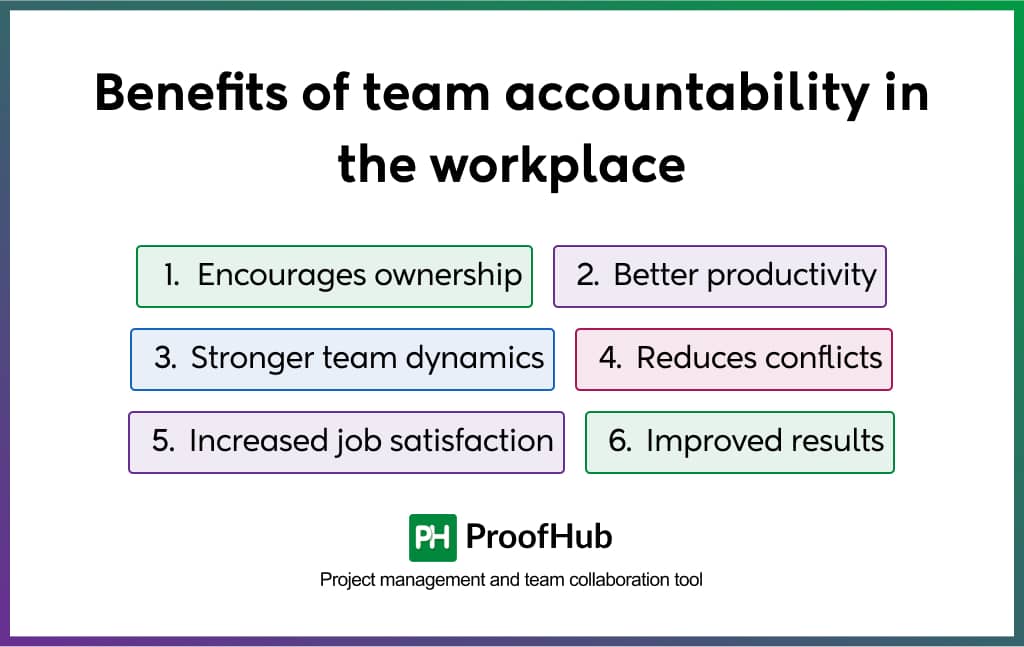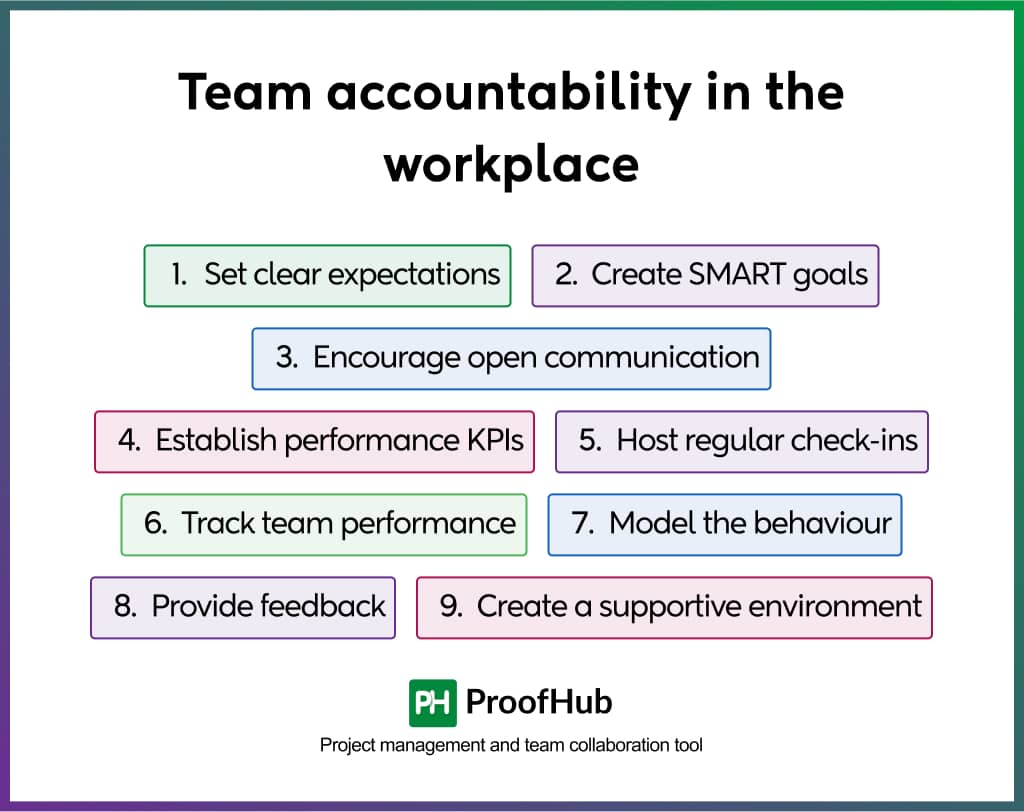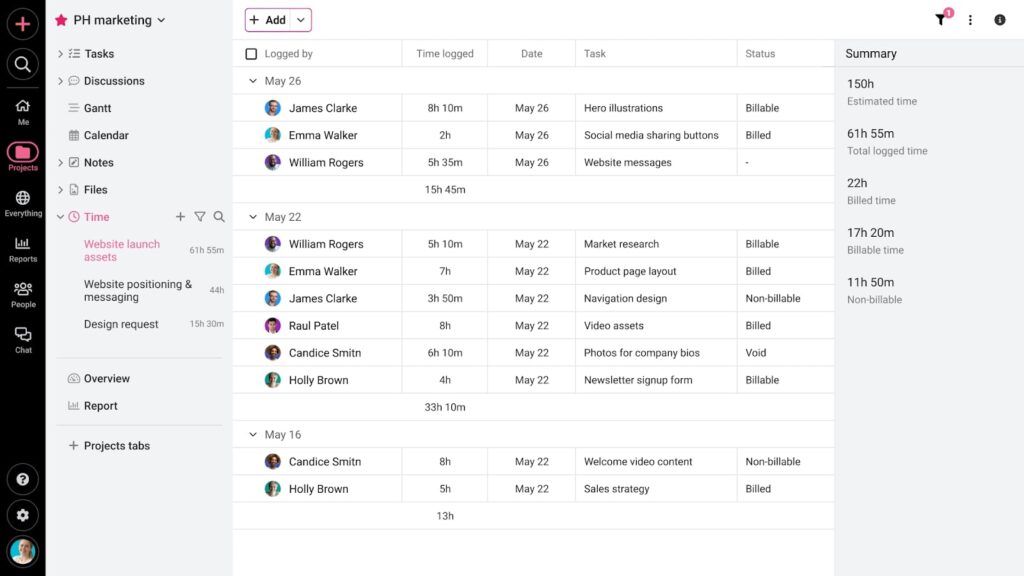Accountability isn’t something you demand – it’s something you inspire. – Sandeep Kashyap, CEO, ProofHub
Every leader desires a team that is running the show on its own – taking ownership, collaborating to solve problems, and staying aligned with strategic goals to make things happen.
But here’s the thing – accountability isn’t something you can enforce; it’s a mindset you have to build.
And without structure and real efforts, accountability remains just a nice idea. Worse, when left unchecked, it turns into frustration, a blame game, and derailed productivity.
I have seen so many managers and team leaders struggle because they expect accountability without ‘enabling’ it. They don’t walk the talk or put in the work to make it a reality. They overlook a fundamental truth—accountability isn’t a rule; it’s a mindset. And it starts at the top.
From setting clear expectations to creating a trust-driven environment, here are 9 practical, real-world team accountability examples you can immediately implement to make it work for better performance and organizational success.
But before we dissect these examples, let’s make sure we’re on the same page, “what accountability actually means”.
What is team accountability in the workplace?
Team accountability is not merely a concept but a mindset, a culture, and a driving force behind high performance.
It refers to a work environment where team members take responsibility, meet commitments, acknowledge mistakes, and own their actions, decisions, and outcomes—both successes and failures.
In other words, accountability is the state of holding others accountable, which the Cambridge dictionary explains as “Someone who is accountable is completely responsible for what they do and must be able to give a satisfactory reason for it.”
Accountability vs Responsibility
There is a fair amount of confusion between responsibility and accountability, and they are often used interchangeably.
However, in simpler terms,
- Responsibility is an obligation
- Accountability is a liability
Where the former can be delegated, the latter cannot.
Teams that do not just fulfill their responsibilities but also embrace accountability are better equipped to deliver results, overcome challenges, and sustain long-term success.
Learn 10 smart ways to hold your employees accountable to excel better in your ventures
Benefits of team accountability in the workplace
The importance of accountability in the workplace is undeniable. It is a cultural shift that reshapes an organization’s core values, behaviors, and operational processes.
From individuals who hesitate to take ownership to a team that is proactively driving results while holding each other accountable, accountability promotes a high-performance environment. It allows teams to build trust with each other and management, strengthen credibility, seize new opportunities, and scale in their industry.
And from what I have learned through my experience, accountability—when done right—enables teams to unlock their full potential. Not only does it drive results, but it also creates a culture of continuous growth and innovation.
Given below are the key benefits of instilling accountability in the workplace:

- Encourages ownership
“Accountability equals ownership. And a sense of ownership is the most powerful weapon a team or organization can have.” — Pat Summitt
Team accountability encourages ownership in the workspace. When almost, if not the entire team takes responsibility for their work, it fosters a culture of accountability—team members get inspired by each other and take responsibility for their actions, decisions, and outcomes.
- Better productivity
When everyone in the team takes full ownership, they proactively seek solutions, complete their tasks, and perform better and smarter. They do not wait for instructions or approvals, instead, they come forward to get things done with initiative and efficiency. This allows them to deliver projects on time without any bottlenecks or delays.
- Stronger team dynamics
“A culture of accountability builds trust among the team. Everyone knows that everyone else will do their part.” – Chris Richardson
When your entire team is confident and self-directed, they trust each other, support each other, and most importantly, hold each other accountable, especially in high-pressure situations. They are more willing to collaborate, share ideas, and take risks when they can rely on each other.
- Reduces conflicts
Accountability eliminates the scope for any rifts that could arise between teams due to miscommunication, unclear responsibilities, or expectations. There is no finger-pointing or blaming because everyone knows their roles and responsibilities. When team members are at odds, accountability shifts the focus from individual faults to collective problem-solving and collaborative success.
Find out 7 big project management conflicts and the right ways to resolve them.
- Increased job satisfaction
It is my strong belief that happy employees drive business success. When employees have a sense of purpose, know they are valued, and understand their contributions matter, they remain content in their roles. They are more willing to put their best step forward and feel motivated to excel. This leads to increased job satisfaction and higher employee retention.
- Improved results
“Accountability is the glue that ties commitment to the result.” – Bob Proctor
Accountability never comes across as fulfilling individual tasks or saying, “I did my part.” Instead, it ensures that every team member takes responsibility for the collective outcome. Understanding that their contribution is linked to others’ success, team members stay invested in ensuring that individual shortcomings do not sacrifice the progression of the entire workflow. Because at the end of the day, only the results matter.
9 Team accountability examples in the workplace
To an extent, I do agree that self-accountability is crucial; leadership plays a significant role in setting the stage for it. After all, inculcating accountability among teams is a leader’s ability to inspire a team to make decisions, take ownership, and own their outcomes.
Now that you know the etymology of team accountability (state of being answerable), let’s move ahead to find out what accountability means and looks like.
Here are 9 real-world examples of team accountability in action and ways to manifest and model them in your workplace without it feeling forced.

1. Set clear expectations
Clarity isn’t just about tasks—it’s about getting everyone on the same page with a shared vision.
“Establishing a culture of accountability begins with clear communication and alignment of expectations and goals. This involves conveying the organization’s vision, mission, values, and strategies consistently. Clearly defining roles, responsibilities, and expectations for each team member is crucial.” – Dhatchana MoorthiFollow, Data Science & Engineering
When your team is aligned and knows what is expected of them, their responsibilities, roles, and how their work contributes to the company’s overall objectives, they tend to take ownership on their own. Also, when you ensure to … on expectations regularly, they move forward with clarity and confidence.
Example: The marketing lead drafts the campaign by Wednesday, while the designers finalize visuals by Friday.
Why it works: When expectations are crystal clear there is no room for ambiguity, misinterpretation, and excuses. It promotes ownership and keeps projects moving in the right direction.
2. Create SMART goals
This is the most obvious yet substantial method of holding your team accountable for their actions. Setting goals is the first step to defining your goal at the end of the project, quarter, or year. When you establish clear goals, teams concentrate and synchronize their efforts to nail the game and obtain substantial results.
Example: A social media team sets SMART goals (Specific, Measurable, Achievable, Relevant, and Time-bound). Increase Instagram engagement by 20% in 3 months through daily posts and influencer collaborations.
Why it works: SMART goals provide direction, purpose, and momentum to help managers compare the team’s progress against defined goals, while the team remains focused and accountable.
Learn to establish project objectives and achieve them using the SMART framework
3. Encourage open communication
When you establish a culture of openness and transparency, accountability feels like a team effort, not a punishment.
Team members do not hesitate to express hidden struggles, raise their opinions, and most importantly, ask for help. This practice helps teams trust each other more, collaborate effectively, and rely on each other for better results.
Example: Open communication is the basis of our workspace. Instead of relying on endless meetings, we prefer using real-time communication tools like ProofHub which has built-in chat, discussion, task comments, reports, and shared notes to inform others and stay updated. Meetings? Only when necessary.
Why it works: Open communication reduces misunderstandings, builds trust, and helps teams hold each other accountable—not just wait for the boss to do it.
Explore our comprehensive list of powerful team communication tools for businesses
4. Establish performance KPIs
When you define clear key performance indicators, you establish a tangible metric to measure team performance. It eliminates the ambiguity of the standard of excellence and quality expected from the team. Team members know what success looks like and do not fear taking ownership; instead, they push through strategically to achieve their targets. By doing this, they can measure their as well as their peers’ performance, fostering a results-driven mindset.
Example: In our team, we set a KPI of 1000 sign-ups a month for every marketing campaign. The target acts as a benchmark for our team to track their performance and adjust strategies, reinforcing accountability for meeting and exceeding those expectations.
Why it works: KPIs make progress visible to managers. Also, it helps teams self-evaluate their performance against the established parameters to stay on track.
5. Host regular check-ins
Quick, structured check-ins ensure everyone is on track without making them feel micromanaged.
“Schedule regular one-on-one meetings and team check-ins to discuss progress, challenges, and goals. These meetings provide opportunities to reinforce accountability and address any issues promptly.” – Ricardo J Flores, Sustainable Business Leader | TradeWinds Vice-President
When teams know they are expected to report on their progress, they naturally own up to their responsibilities and stay proactive. However, there are chances for these check-ins to look and feel like micromanagement if not handled carefully; these could derail the authenticity of the process.
Example: A scrum team holds daily stand-ups to review tasks, share progress, flag blockers, and align priorities. This routine helps the team of developers stay accountable for their commitments.
Why it works: Regular check-ins ensure alignment, help identify roadblocks, and create a shared sense of responsibility.
6. Track team performance
Performance tracking is another important strategy to increase accountability amongst teams. When managers keep a check on the team’s performance, accountability becomes a default nature. They can ensure productivity by making responsibility visible and explicit, avoiding any chances of a team looking visibly busy to mask inefficiency.
Example: A marketing team uses time trackers and time utilization reports to compare estimated time vs the actual time spent by the team on tasks.
Why it works: Performance tracking progress helps managers stay updated on the progress and prevents teams from just looking busy.

Explore our guide on how to track team progress for better productivity
7. Model the behaviour
I firmly believe that how your team perceives accountability has a lot more to do with you than with themselves. You cannot expect your team to take ownership if you can’t even justify your own actions.
“No shame in leaders admitting they’ve made a mistake – this way not only do the best ideas win, but everyone in the team knows ego is best left out at the door. – Ibad A.
So, ensure that you not only become the preacher of accountability, but it reflects in your behavior, actions, and decisions. Even if it means being vulnerable when accepting your mistakes or acknowledging failures, own your role in setting the tone and standard for the team’s performance and commitment.
Example: This is quite personal. So, some time back, I pushed an aggressive ad campaign without thinking it through (I admit). I was pretty convinced that it would drive high engagement and generate leads. A week or so in, the results came out different—low CTRs, high bounce rates, and poor ROI.
Instead of deflecting, I called a meeting, admitted my misjudgment, asked for input, and optimized our approach. Owning my mistake didn’t just fix the campaign—it built trust and accountability across the team.
Why it works: When leaders walk the talk, it creates a ripple effect – the team follows suit.
8. Provide feedback
Feedback isn’t about criticism—it’s about guiding, growth, and improvement.
“Everyone requires feedback, organizations, teams, leaders, and individuals. Without feedback, we risk breaking the circular process of improvement. When thinking about encouraging accountability, one of the key ways is to allow for a 2-way feedback, this not only opens up communication but also breaks the stigma of barriers between managers and managees” – Yasir A. Jamal, Chief Supply Chain Officer at Nahdi Medical Co.
Not only does it highlight the key areas for improvement and growth, but it also reinforces strengths, acknowledges wins, and provides direction. This reflection helps employees feel confident and take ownership of their work. Managers should provide constructive feedback to the team which helps boost their morale and persuades them to reach their maximum potential.
Example: Instead of vague praise like “good job,” a manager gives specific feedback: “Your campaign had great visuals, but let’s refine the messaging for better conversions.”
Why it works: Constructive feedback reinforces strengths, corrects weaknesses, and encourages accountability without making people defensive.
9. Create a supportive environment
Accountability isn’t about calling people out—it’s about lifting them up.
If you want to create a culture of accountability, make sure you create an environment that lifts up the team when they struggle, instead of tearing them down. This may include offering training, guidance, coaching, tools, etc. Also, there might be instances when team members’ capabilities are at par with the expectations, but they lack the motivation to perform at their best. This support encourages employees to take the lead and own their responsibilities.
Example: After multiple failed attempts, a manager arranges targeted training and provides access to online resources. The result? The team levels up and meets their goals.
Why it works: A supportive environment encourages employees to feel valued and take initiative rather than fear failure.
Explore 19 tested-and-tried tips to improve the team’s productivity in 2025
Conclusion
From where I stand, accountability is a defining factor that differentiates high-performing teams from those constantly avoiding responsibilities and shifting blame.
Regardless of what your team ranks on the accountability meter, you have the power to push the needle to the maximum. Whether it’s setting clear expectations or leading by example, there are numerous real-world team accountability examples for you to get inspired.
Just make sure to stay consistent, lead with integrity, and inspire until accountability becomes second nature to your team.
FAQs
What are the 5 C's of team accountability?
The 5C’s of team accountability include:
- Common purpose: Involve stakeholders from the start to ensure expectations align with long-term objectives.
- Clear expectations: Define a detailed project scope outlining goals, deliverables, deadlines, and responsibilities.
- Communication and alignment: Keep teams informed through regular meetings, documentation, and training to ensure they remain aligned.
- Coaching and collaboration: Address skills gaps with personalized coaching and peer support to promote continuous learning.
- Consequences and results: Track progress, measure impact, and celebrate success to reinforce accountability and motivation.
How does team accountability contribute to workplace culture?
Team accountability plays a crucial role in shaping workplace culture. When a team shifts from avoiding responsibility to taking ownership, it fosters a culture of trust, reliability, and performance. This push for transparency and shared responsibility creates an environment where employees feel empowered, motivated, and aligned toward common goals.
How can team accountability improve productivity?
Team accountability is a driving force behind productivity. When the entire team commits beyond just completing tasks, they become more proactive in solving problems, optimizing workflows, and delivering results with greater efficiency. By fostering a culture where everyone holds themselves and each other accountable, teams tap into their collective strengths to achieve higher performance levels.
How to be accountable at work?
Being accountable at work is an intentional choice that talks a lot about – commitment, learning, and taking responsibility
- knowing your responsibilities and taking full ownership of your role.
- Delivering on commitments and meeting deadlines consistently.
- Owning your actions, decisions, and results – both success and failure.
- Going beyond completing tasks to continuously improving processes and driving impact.

